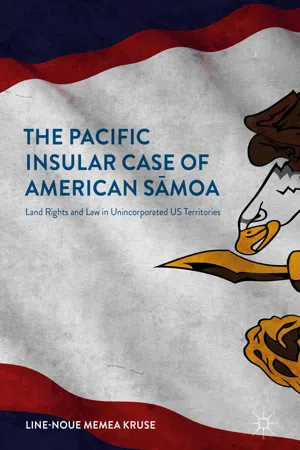The February 19, 1900 General Order No. 540 of the US Naval Department was enacted vis-à-vis Executive Order No. 125-A,
thus placing the “Sāmoan Group”
under the control of the Naval Department.1 The Naval Department had supreme legislative, executive, and judicial power over the Sāmoan Group
(Gray 1960, p. 232).
The Naval
Administration
instituted American property laws alongside the traditional Sāmoan land tenure system in American Sāmoa. One of the significant property laws introduced was adverse
land possession
. Adverse land ownership rights
were determined to be a milestone of enlightened western jurisprudence for land issues where Sāmoan customary laws were deemed insufficient, without merit, and uncivilized. The evolution of adverse land possession
principles and rights in American Sāmoa has worked to erode the traditional communal land
tenure system and
fa’asāmoa
2 culture
(customs
and daily respectful behavior practiced by every Sāmoan
) by laying the groundwork for individually owned land rights. Individually
owned land
classification is incongruent with the Sāmoan communal
land
tenure system. This book examines the early Naval Court
decisions and the incorporation of adverse land
possession rights that has evolved into the individually owned land
classification in American Sāmoa.
The system of classifying land as individually owned
takes away precious land holdings from communal tenure, which is not regulated or monitored by the American Sāmoa Government. Since the Naval Court decisions, more and more lands have become individually owned, a trend that has damaged the communal land
holding system and the
fa’asāmoa
culture
. Preserving what remains of traditional land tenure cannot be achieved without examining the political and legal relationships between American Sāmoa and the United States. I examine these relationships to recommend practical alternatives to shelter Sāmoan cultural institutions within the American body-politic.
Cultural identity is the core basis of the Sāmoan
people, and communally owned lands
are the central foundation that will allow our cultural identity to survive in today’s world. Communally owned lands
provide a space for Sāmoans
to live together with
āiga
(family, kin) members in a village setting to practice our Sāmoan traditions. The
fa’amātai
is
the Sāmoan chiefly system and is fundamental to the sociopolitical organization of the Sāmoan society. It is the traditional system of governance. The fa’amātai system exists because there are communal lands
for all members of the
āiga
to serve and protect the collective interests. The
fa’amātai
system is based on
āiga
clanship, composed of immediate
āiga
(father, brother, etc.) and a nexus of
āiga potopoto
(extended family). Every single
mātai
(chief)
title has authority through which they exercise their oversight responsibilities over the
āiga
. The
mātai
has stewardship over the communal lands
of their
āiga
and thus directs and supervises the
āiga
living on these land parcels according to tradition, cultural obligation, and duty.
Reference
Gray, John A. 1960. Amerika Sāmoa: A History of American Sāmoa and Its United States Naval Administration. Annapolis: United States Naval Institute.
This Sāmoan phrase means to “have a vision while on a journey.”
End AbstractAmerican Sāmoa is in the Pacific Ocean and is the only US territory south of the equator, at 14 degrees south latitude and approximately 170 degrees west longitude. American Sāmoa is about 2300 miles south-southwest of Hawai’i, over 4100 miles southwest of San Francisco, and 1600 miles east-northeast of New Zealand. American Sāmoa consists of five volcanic islands and two atolls, called Rose Island and Swains Island. Tutuila, Aunu’u, Ofu, Olosega, and Ta’ū are the five main islands. The capital, Pago Pago, is located on the island of Tutuila, the most densely populated island that holds over 90 percent of the territory’s residents. American Sāmoa’s landmass is composed of 76 square miles; the island of Tutuila is the largest island with 56 square miles, while the remaining four islands are composed of 20 square miles.
American Sāmoa has a mountainous steep terrain and is in the path of the southeast trade winds, with an annual tropical rainfall that averages between 90 inches per year in the drier areas to 300 inches per year in the mountainous areas (2286 mm and 7620 mm) (National Park 2013, website). October to May is the rainy summer season (locals refer to it as the cyclone period), and the cooler, drier season occurs between June and September. American Sāmoa’s topography is nearly two-thirds steep m...
